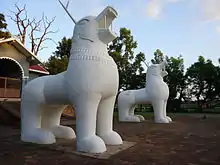Nongshaba
Nongshaba (Meitei: ꯅꯣꯡꯁꯥꯕ) or Kanglasha (Meitei: ꯀꯪꯂꯥꯥꯁꯥ) is a lion-like Dragon God in Sanamahism (Manipuri religion) as well as Manipuri mythology.[4][5][6] He is worshipped by the people of both the Ningthouja dynasty as well as the Moilang dynasty.[7] He is worshipped as the greatest of the Umang Lais (Deities associated with the sacred groves) in Kangleipak (present day Manipur) since time immemorial. A pair of two huge structure of the dragons are still standing inside the Kangla Palace of Manipur.[8][9][10]
| Nongshaba | |
|---|---|
| Member of Umang Lai and Meitei deities | |
 | |
| Affiliation | Sanamahism and Manipuri mythology |
| Texts | PuYa |
The deity is worshipped by the Mantak villagers especially during summer season to be blessed with long life.[11]
History
The deity was brought from Moirang by the two men to the kingdom of the Ningthouja dynasty. King Khagemba worshipped the god by building a temple dedicated to Him.[12] It was during the reign of the king that the position and pantheon of Nongshaba grew up in the history.[13]
Mythology
In Manipuri mythology, he is one of the three sons of Atingkok Maru Sidaba, the creator of the Universe. He is the brother of Lainingthou Sanamahi and Pakhangba.
Text
Nongshaba Laihui (Nongsaba Laihui) Puya is a Meitei Manipuri text written about the magnificent Nongshaba (Kanglasha), the second son of the Universal Lord. He’s also known as "Tholbu Chinglen Nongdai Ningthou" and is not much referred to as having assigned or taken a great role in the creation of the universe or stood in the way of his elder brother Asheeba while executing the gigantic task.
Nor like the two brothers does he occupy so high a place in the Meitei Manipuri pantheon, though successive kings invariably dedicated a temple to Him in the Royal premises. Nongshaba like his younger brother Pakhangba has no human descendants nor does He manifests in human form like his elder brother Sanamahi as given in the manuscripts, the Pakhangba Laihui and the Sanamahi Laihui.
At the outset, the writer is all effusion of His resplendent glories:
“Thou, Lord of Gods and Goddesses together with the exalted Awang Phatlou Laimakhomba (Sanamahi), like two strands of the thread entwined, exercise Thine sway over the earth and in doing so effulgent rays radiate from Thee. Thus with the reflected light, all other divine beings take on a dazzling look and are then made to stand guard at the four corners, eight directions and sixteen sub-directions. All the souls of the living creatures emanate from Thee and again like beads of gold strung together Thou art in complete harmony with Nongda Lairen Pakhangba who can be a man in the night and a God during the day. There Thou takest Thine name as Chinglen Nongdai Ningthou and with Thine consort Thongnang Leicha Khombi, Thou becomest like innumerable Suns among the myriad stars… On both of Thee attend the God of the death and the God of the westerly directions, who hold ornamental receptacles for delicacies. And the enchanting seven goddesses gently play the fans made of peacock feathers for Thy pleasure. O Powerful One! Thou holdest intake the seven folds of the sky above and the earth down below with dowels of iron…”
-Nongshaba Laihui.[14]
Real Structures

Some of the most significant structures of Kanglasha or Nongshaba are found in Kangla Palace of Manipur. Unfortunately, they were destroyed by the British officials during the annexation of the Kangla Palace on June 20, 1891 AD.[15]

Later, when Manipur got independence in 1947, the structures were rebuilt with concrete items.[16][9][17]
Gallery


.jpeg.webp)

References
- https://books.google.co.in/books?id=f3AMAQAAMAAJ&q=lainingthou+nongsaba&dq=lainingthou+nongsaba&hl=en&sa=X&ved=2ahUKEwiMmPfY983uAhWQ8HMBHUIaA1IQ6AEwAXoECAIQAg
- https://books.google.co.in/books?id=q5eBAAAAMAAJ&q=nongshaba&dq=nongshaba&hl=en&sa=X&ved=2ahUKEwjRw9qg9M3uAhWG4nMBHerRByIQ6AEwAnoECAAQAg
- https://books.google.co.in/books?id=Z6d-IyINtk4C&pg=PA582&dq=kanglasha&hl=en&sa=X&ved=2ahUKEwia2Nfala3uAhX37XMBHcQSBGAQ6AEwAHoECAEQAg#v=onepage&q=kanglasha&f=false
- https://books.google.co.in/books?id=f3AMAQAAMAAJ&q=lainingthou+nongsaba&dq=lainingthou+nongsaba&hl=en&sa=X&ved=2ahUKEwiMmPfY983uAhWQ8HMBHUIaA1IQ6AEwAXoECAIQAg
- https://books.google.co.in/books?id=q5eBAAAAMAAJ&q=nongshaba&dq=nongshaba&hl=en&sa=X&ved=2ahUKEwjRw9qg9M3uAhWG4nMBHerRByIQ6AEwAnoECAAQAg
- https://books.google.co.in/books?id=Z6d-IyINtk4C&pg=PA582&dq=kanglasha&hl=en&sa=X&ved=2ahUKEwia2Nfala3uAhX37XMBHcQSBGAQ6AEwAHoECAEQAg#v=onepage&q=kanglasha&f=false
- https://books.google.co.in/books?id=F1luAAAAMAAJ&q=nongshaba&dq=nongshaba&hl=en&sa=X&ved=2ahUKEwjRw9qg9M3uAhWG4nMBHerRByIQ6AEwAXoECAMQAg
- https://books.google.co.in/books?id=Z6d-IyINtk4C&pg=PA582&dq=kanglasha&hl=en&sa=X&ved=2ahUKEwinjJvK-M3uAhVo6XMBHQ7GBRkQ6AEwBHoECAQQAg#v=onepage&q=kanglasha&f=false
- "Kanglasha by Prabin Pebam on Dribbble". Dribbble.com. 2013-01-09. Retrieved 2020-01-16.
- "Rediscovering a heritage". Frontline.thehindu.com. Retrieved 2020-01-16.
- https://books.google.co.in/books?id=_BtuAAAAMAAJ&q=nongsaba&dq=nongsaba&hl=en&sa=X&ved=2ahUKEwj8yNHQ9c3uAhVqFLcAHUX0BTEQ6AEwAHoECAAQAg
- https://books.google.co.in/books?id=af4dAAAAMAAJ&q=nongsaba&dq=nongsaba&hl=en&sa=X&ved=2ahUKEwj8yNHQ9c3uAhVqFLcAHUX0BTEQ6AEwAXoECAMQAg
- https://books.google.co.in/books?id=PgHgCwAAQBAJ&pg=PA110&dq=nongsaba&hl=en&sa=X&ved=2ahUKEwj8yNHQ9c3uAhVqFLcAHUX0BTEQ6AEwAnoECAQQAg#v=onepage&q=nongsaba&f=false
- https://books.google.co.in/books?id=f1puAAAAMAAJ&q=nongshaba+laihui&dq=nongshaba+laihui&hl=en&sa=X&ved=2ahUKEwiIyaKdra3uAhX1wTgGHUTqDh8Q6AEwAXoECAEQAg
- http://e-pao.net/GP.asp?src=8..101208.dec08
- http://e-pao.net/GP.asp?src=8..101208.dec08
- "Kanglasha : E-Pao YellOut". E-pao.net. 2009-06-05. Retrieved 2020-01-16.
External links
- https://www.mapsofindia.com/india-tour/manipur/kangla/the-ancient-capital-of-manipur/
- https://e-pao.net/yellout/Kanglasha/
- https://m.telegraphindia.com/states/north-east/kanglasha-replica-blast-on-reel-corporation-records-event-as-part-of-a-documentary-on-kangla-fort/cid/519436 (This page highlights about the destruction of the Kanglasha structures)